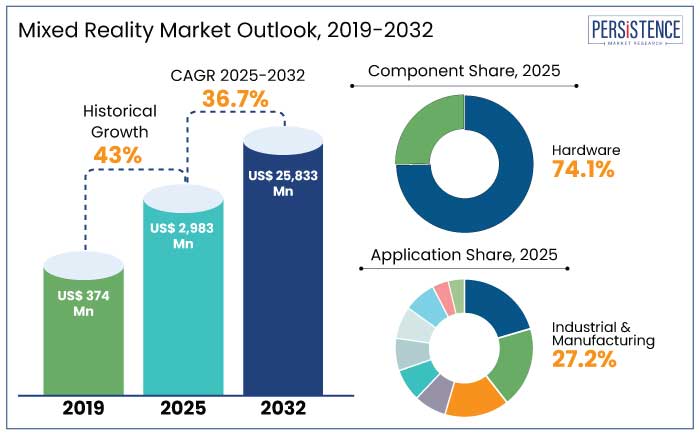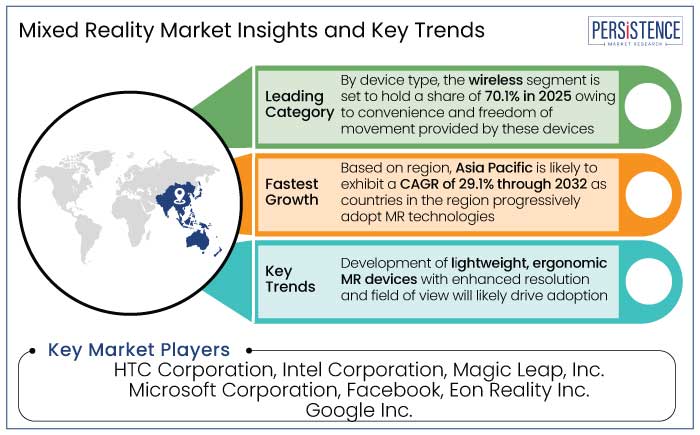ID: PMRREP33443| 189 Pages | 21 Jan 2025 | Format: PDF, Excel, PPT* | IT and Telecommunication

The global mixed reality market is predicted to reach a size of US$ 2983 Mn by 2025. It is anticipated to witness a CAGR of 36.7% during the forecast period to attain a value of US$ 25833 Mn by 2032.
Mixed Reality (MR) is estimated to transform assembly lines, maintenance, and training programs. By 2030, industrial applications are predicted to account for 25% of the global MR industry. The technology is anticipated to play a pivotal role in medical training, surgery simulations, and patient care.
Immersive learning platforms are projected to gain traction, especially in emerging markets. Education applications are predicted to represent 15% of the market by 2032, owing to rising adoption in schools and universities.

Key Highlights of the Industry
|
Market Attributes |
Key Insights |
|
Mixed Reality Market Size (2025E) |
US$ 2983 Mn |
|
Projected Market Value (2032F) |
US$ 25833 Mn |
|
Global Market Growth Rate (CAGR 2025 to 2032) |
36.7% |
|
Historical Market Growth Rate (CAGR 2019 to 2023) |
43% |
Asia Pacific mixed reality industry is anticipated to emerge as the leading region with a share of 38.2% in 2025. Growth in the region is highly driven by the increasing adoption of MR technologies across various sectors, including healthcare, education, manufacturing, and entertainment.
China’s developments in technology, coupled with large-scale investments in MR for industries such as entertainment, education, and healthcare, play a key role in driving the market. The growing technology sector in India along with an increased adoption of MR in education and healthcare and government initiatives further contribute to the industry’s growth.
Japan's robust technological infrastructure and high demand for MR applications in manufacturing, automotive, and healthcare contribute to expansion. With a large and tech-savvy population, Asia Pacific has witnessed a robust consumer demand for immersive technologies like mixed reality. Young and tech-savvy consumers in urban areas, particularly in China, Japan, and South Korea, are driving the growth of MR applications in gaming, entertainment, and social media.
Hardware is anticipated to hold a share of 74.1% in 2025. The segment is experiencing significant growth as demand for MR headsets, smart glasses, and other wearables continues to rise. These devices are essential for delivering immersive experiences in mixed reality.
Growth is driven by increasing use of MR hardware in various sectors such as entertainment, healthcare, education, and industrial applications. The development of unique MR headsets, such as Microsoft’s HoloLens, Magic Leap, and Oculus Quest, is crucial to the growth of the MR market. These devices combine augmented reality (AR) and virtual reality (VR) technologies, providing users with a fully immersive experience. Their enhanced features like improved field of view, faster processing speeds, and better comfort, have driven their adoption across businesses and consumer markets.
The demand for MR smart glasses is also increasing, particularly in enterprise applications. Companies like Vuzix and Google are developing lightweight, wearable MR solutions that are being used for hands-free tasks, such as maintenance, logistics, and healthcare.
Industrial and manufacturing is estimated to hold a share of 27.2% in 2025. MR technologies enable manufacturers to visualize, simulate, and optimize their operations, leading to increased efficiency and decreased errors. MR is being used extensively for training employees in a safe and risk-free environment.
In the industrial sector, workers can practice complex tasks using MR headsets without the need for physical prototypes or expensive machinery, thereby decreasing training costs and time. MR enables real-time remote collaboration between factory workers and experts. With MR glasses or headsets, workers can receive on-the-spot guidance from specialists, decreasing downtime and increasing productivity.
Rapid growth of MR in this sector is due to its ability to streamline processes and improve operational efficiency. Manufacturers use MR for predictive maintenance, asset management, and repair operations. With MR headsets, technicians can access real-time data and step-by-step instructions overlaid on equipment, improving the speed and accuracy of repairs.
Wireless device type is anticipated to hold a share of 70.1% in 2025. Wireless MR headsets eliminate the need for physical connections, providing users with greater freedom of movement. This is particularly important in applications like gaming, training, and industrial simulations where mobility enhances realism. For instance,
The roll-out of 5G networks and the adoption of Wi-Fi 6 have dramatically improved the bandwidth, latency, and stability of wireless connections. This has enabled wireless MR devices to deliver high-quality experiences previously only possible with wired solutions. 5G connectivity provides low-latency and high-speed data transfer, which is crucial for real-time MR applications. For example,
As consumer preference shifts toward more convenient and user-friendly devices, wireless MR headsets have gained popularity. They allow for quicker setup times and better comfort compared to wired alternatives. Consumer electronics brands, including Meta and HTC, have prioritized the development of wireless MR devices to meet demand.
Potential growth in the global mixed reality market is predicted to be driven by MR applications in urban planning, virtual tourism, ecommerce, and telemedicine. Countries including China, Japan, and the U.S. are investing in MR technologies for defense, smart cities, and educational purposes.
Innovations in MR headsets, smart glasses, and wearables are estimated to decline costs, thereby making MR accessible to small businesses and consumers. Mixed reality is anticipated to become integral for training, remote collaboration, and product design, especially in manufacturing and healthcare.

The mixed reality market growth was robust at a CAGR of 43% during the historical period. This growth was primarily driven by early adopters in gaming, entertainment, and enterprise applications like training and simulation. The COVID-19 pandemic accelerated the adoption of MR technologies as businesses sought remote collaboration tools and immersive solutions for training and education.
Increasing investments in MR hardware and software helped the market to reach around US$ 3 Bn, showing continued momentum in industries like healthcare, education, and retail. The gaming and entertainment industries drove demand for immersive content, particularly in countries with strong digital ecosystems like the U.S., China, and Japan.
The forecast period is anticipated to integrate AI and 5G, thereby enhancing MR capabilities, providing faster, immersive, and personalized experiences. Falling costs of MR hardware are likely to make the technology accessible to small and medium-sized businesses and individual consumers.
Focus on Urban Planning and Smart Cities to Boost Demand
By 2030, 60% of smart cities worldwide are projected to integrate MR technologies into their urban planning processes. MR enables architects, urban planners, and engineers to create and interact with 3D models of urban projects. This enables better planning, design accuracy, and identification of potential issues before construction begins. For instance,
MR applications assist governments and urban planners to communicate complex projects to the public in an engaging and visual format. Surveys show that MR-based public engagement can increase community understanding and project approval by 50%.
MR aids in managing and maintaining city infrastructure like roads, bridges, and public utilities by providing real-time visual data overlays. For instance,
Surging Development of the Gaming Industry to Push Demand
The consumer market is increasingly adopting lightweight, user-friendly MR wearables such as smart glasses, MR headsets, and contact lenses. For instance,
MR is transforming the gaming industry by enabling immersive experiences where physical and virtual worlds merge. For instance,
Virtual concerts, MR-enabled movie theaters, and interactive storytelling are growing trends in the entertainment sector.
MR-enabled fitness solutions, such as virtual workout classes and immersive exercise routines, are becoming popular among consumers. Companies like Peloton are integrating MR into home workout systems for enhanced engagement.
Complexity in Development and Integration May Hinder Demand
Developing MR applications require expertise in multiple new technologies including 3D modelling, AI and ML, and real-time data processing. Companies struggle to find skilled developers, resulting in longer development cycles and higher costs. For example,
Development of MR applications involves substantial investments in software tools, skilled professionals, and testing. Small and medium-sized enterprises (SMEs) find it difficult to afford custom MR solutions.
The lack of standardization across MR hardware and software platforms complicates integration. Different MR devices (Microsoft HoloLens and Meta Quest Pro) often require tailored applications, creating fragmentation. Businesses face challenges in developing applications that work seamlessly across multiple devices.
Demand for Defense and Public Safety Applications to Skyrocket
MR enables realistic, immersive training for military personnel, simulating combat scenarios, equipment handling, and tactical maneuvers. The U.S. Army uses MR for soldier training through programs like the Integrated Visual Augmentation System (IVAS), which overlays tactical data on the user's field of view. For example,
MR creates virtual battlefields where soldiers can train for urban combat, disaster response, and mission rehearsals without physical deployments. It also assists in mission planning by allowing commanders to visualize terrains, analyze tactical options, and simulate operational outcomes in real-time.
MR-enabled systems provide 3D maps of conflict zones, helping strategists identify potential threats and optimize troop movements. MR further enhances mission accuracy by 25% to 30%, reducing the risk to personnel and resources.
MR to be Integrated into Virtual Classrooms and Student Orientations
MR brings subjects like history, science, and geography to life, enabling students to explore virtual environments and 3D models. Students can explore ancient ruins, the human anatomy, or the solar system in an immersive environment. For example,
MR also enables virtual classrooms where students can interact with instructors and peers in a shared virtual space. Universities are adopting MR for virtual campus tours, student orientation, and collaborative research projects. Medical students use MR to simulate surgeries, gaining hands-on experience in a risk-free environment.
MR-enhanced medical training can improve procedural accuracy by 45%. Fields like architecture, engineering, and arts benefit from MR tools as it enables students to visualize and manipulate 3D designs. For instance,
Companies in the mixed reality market are developing cutting-edge hardware like unique headsets, wearables, and sensors to enhance user experience. They are also creating powerful software platforms and applications to support immersive MR experiences for various industries like healthcare, education, entertainment, and manufacturing.
Businesses are further collaborating with tech giants, start-ups, and industry leaders to leverage complementary expertise. For instance, partnerships with cloud service providers assist in delivering more scalable MR solutions. They are teaming up with content creators, developers, and companies across various sectors to build tailored MR applications.
Brands are continuously investing in research and development activities to enhance the realism, interactivity, and usability of MR experiences. This includes developments in AI, machine learning, computer vision, and haptic feedback. Manufacturers are also enhancing the integration of MR with other technologies like AI and 5G for faster, more immersive experiences.
Recent Industry Developments
The market is anticipated to reach a value of US$ 25833 Mn by 2032.
In a mixed reality experience, a digital object like a book can be anchored to a specific location in the real world, say by a bedside table.
Mixed reality is used in applications including design, education, entertainment, military training, healthcare, and human-in-the-loop operation of robots.
Prominent players in the market include HTC Corporation, Intel Corporation, and Magic Leap, Inc.
The market is predicted to witness a CAGR of 36.7% throughout the forecast period.
|
Attributes |
Detail |
|
Forecast Period |
2025 to 2032 |
|
Historical Data Available for |
2019 to 2023 |
|
Market Analysis |
US$ Billion for Value |
|
Key Regions Covered |
|
|
Key Market Segments Covered |
|
|
Key Companies Profiled in the Report |
|
|
Report Coverage |
|
|
Customization and Pricing |
Available upon request |
By Component
By Device Type
By Application
By Region
Delivery Timelines
For more information on this report and its delivery timelines please get in touch with our sales team.
About Author